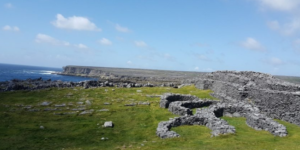The Aran Islands are well known as a beautiful holiday destination for those seeking dramatic scenery and a taste of authentic Irish culture. However, there is more to them than meets the eye, as these six facts show.
A Long History
The islands have been home to many different settlers over the centuries, reaching back over 2,500 years. Dun Aengus, a fort on Inishmore, dates to 1300 BC. In fact, the Aran Islands are considered to have more ancient monuments than anywhere else in Europe.
The Aran Islands are also renowned as a place of Christian pilgrimage, with monasteries on each of the three islands. The islands’ patron saint, St Enda, is said to have miraculously travelled there in a boat made of stone.

The thatched houses typical of the Islands usually kept the front and back doors held open. This helped to keep the home well aired and also created a friendly, welcoming impression. There were superstitions about leaving through the back door- guests were not permitted to do so, for fear of bad luck. However, if a member of the household were to pass away, it was traditional that they would be carried out in their coffin through the rear exit.
Myths and Traditions
It’s a place where myths are still revered: there is still talk of faeries at the fort Dun Fearbhai. Another superstition relates to the story of a witch living on the islands who protected them from the British landing by conjuring powerful sea storms. The famous playwright J.M. Synge took great inspiration from the tales he heard whilst living there.
The Aran Islands are rightly famous for their intricate cabled knitwear, which has become popular worldwide. It’s said that each family had its own distinct designs, but recurring motifs such as the honeycomb stitch were supposed to bring good luck. Today, traditional Aran sweaters are as practical and stylish as ever. You can find sweaters and mens designer t shirts at EJ Menswear.

Fishing is still the main way of life on the islands, although tourism also provides revenue in the summer months. Though the fishermen were highly skilled at their work, it used to be traditional that they were unable to swim: the reasoning being that they would therefore be more cautious towards the wild seas they faced.

